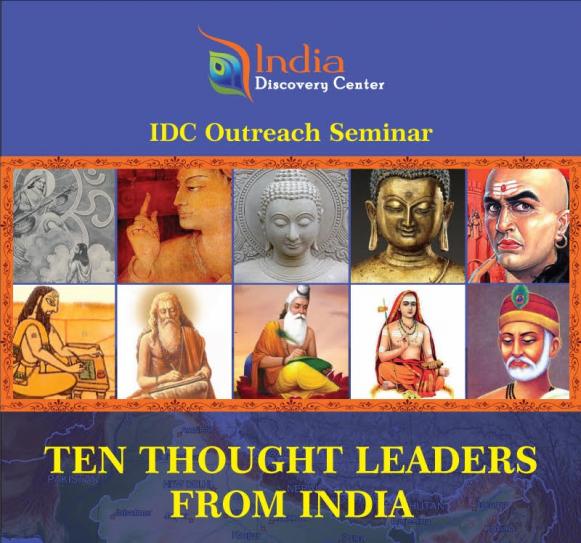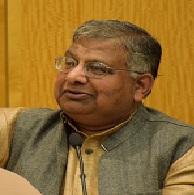Contribute
| IDC: Ten Thought Leaders From India |
V. S. Ramapriya
05/20/2021
“Ten Thought Leaders from Dr. Misra opened the talk quoting Mark Twain, during his travel around the world in Bombay in 1996, he exclaimed India as, ‘the land of dreams and romance’, ‘country of hundred nations and hundred tongues’, ‘all men desire to see, and having seen once, by even a glimpse, would not give that glimpse for the shows of all the rest of the globe combined.’ Dr Misra suggested that the series would try to unravel what makes He suggested that the sage yÄjñavalkya याजà¥à¤žà¤µà¤²à¥à¤•à¥à¤¯ may be taken as the first thought leader, whose name has lived the flow of time. It is possible that there were many persons with that name through the time, but one associated with the Bá¹›hadÄraṇyaka upaniá¹£at (बृहदारणà¥à¤¯à¤• उपनिषतà¥) appears most interesting. The date likely would be 1700BCE. He is known for proposing the first original cosmology of “Mind-Speech-Life†मन-वाकà¥-पà¥à¤°à¤¾à¤£ troica of Indian philosophy. The mind is dense and dark, it is explored by speech as a tool and together they create the life-force to do work. YÄjñavalkya brings in the concept of eternal Brahman and tells his wife “By this Immutable, O GÄrgÄ«, the space is pervaded!†The next in series according to Dr Misra would be Sri Krishna, who possibly flourished around 1500BCE. Given a non-human pedestal in literature, Sri Krishna looms large as the original analytic teacher of the principles of yoga. Yoga is excellence in work and to accept the universe as one. Non-differentiation and non-competition are the pathways to yoga. Sri Krishna was probably an evangelist, his teachings were recorded by the later poets in the text Bhagavad Gita (à¤à¤—वदà¥à¤—ीता), incorporated in the epic Mahabharata. Quoting him – “The non-delusional ones, who are free from pride and delusion, who are free from the mistakes through attachment, who are spiritual, who are free from the desires, who have released themselves from the duality of happiness and sorrow, reach the Immutable state.†The next leader that Dr Misra referred to was the Monk Mahavira. Recorded as the twenty-fourth Tirthankara in the line of teachers in Jainism, Mahavira became a champion of nonviolence. Nonviolence in speech and mind was a new concept. He conceived a soul in each body and declared the eternity of soul through transformation. The transformation is caused by karma, a residual marker on the soul as a causal result of our actions. He declared that the soul can only get liberation when freed from all karma – hence “ one must curb the activities of one’s sense organs and must annihilate all passions through three modes of activity- mind, speech, and body, and in a three-fold manner of- doing, causing to be done and approving the action.†Chronologically Gautama Buddha was the next. A genius preacher of his time, he was called the “enlightened one†because of his analysis of human grief. He enunciated that the greed was the root of all evil and all pain. Greed is natural and is built in to the humans. Human greed can only be succumbed by restraining it. A clean mind is achieved by practicing a three-fold path: one who takes shelter in the Buddha, observes righteous conduct and lives in a community of practitioners. Buddha preached the Miiddle path, not extreme renunciation nor indulgence in senses. He called it The Buddha way. Dr. Misra introduced the 5th century BCE grammarian Panini next. Panini became the culmination of the stages of analysis in Indian thinking resulting in the standardization of language. He compiled all existing grammatical principles into a synthetic system that has remained as a standard to all languages until today. The rules had to be memorized and he invented various techniques of cryptography to reduce the details into condensed units. He became the forerunner of the analytic tools in mathematics that had its large expansion in The next thought-leader in sequence to be introduced was the economist Chanakya (चाणकà¥à¤¯) of 4th century BCE. A great intellect, he served as a Minister to the Maurya king. Considered as the visionary architect of He recorded his findings in a massive text called arthaÅ›Ästra (अरà¥à¤¥à¤¶à¤¾à¤¸à¥à¤¤à¥à¤°)’. The seventh thought-leader in the list was VÄlmÄ«ki (वालà¥à¤®à¥€à¤•à¤¿) of 2nd century BCE, who is credited with the composition of the epic RÄmÄyaṇa रामायण – the sourcebook of ethics and social life in Indian culture. Written in simple language, the epic talks about the legends of a virtuous young man who is determined to live a life of idealism. RÄma in the story has been accepted as a divine incarnation in later Indian literature. The text is known for its aesthetic beauty of storytelling and creating the first documentation of geography and the vegetation in Dr Misra chose VyÄsa (वà¥à¤¯à¤¾à¤¸) – compiler of the epic MahÄbhÄrata (महाà¤à¤¾à¤°à¤¤)’ as the next thought leader, formally assigned 1st century BCE. Though the epic is a collection of many stories and might have evolved through time, Poet VyÄsa is given the credit for its final compilation. Unlike the epic RÄmÄyaṇa, the MahÄbhÄrata is a story of conflicts and contradictions as is confronted in daily life. It is a story of understanding and character building. Knowing and realizing one’s own faults are the greatest education of all. Life is not linear, but a product of multiple constraints each with its strong pull. MahÄbhÄrata creates many real-life characters who are strong, skilled and handicapped through their own weakness. There is no perfection in human life! A thousand years go by to bring the next though-leader – the young monk S’aá¹…kara (शङà¥à¤•à¤°) – in 800CE, who transformed Finally, Dr Misra presented his last selection with the fifteenth century mystic weaver-poet KabÄ«r (कबीरà¥). Being disturbed by the fanatical views of the priestly class in different religions KabÄ«r took upon himself to teach pure spirituality by composing simple verses. He emphasized the old thoughts that divinity lives inside the man and not outside in the rituals or in formal attires. He was a man of the street and lived his life in the most ordinary manner to understand the struggles in life. His talents were in reducing the complex spiritual analysis into memorable couplets. His verses classed as Dr. Misra took a few questions and suggested that each of the thought-leaders need more analysis in the path of building Indian culture. He expressed hope that the outreach lectures may generate further interest in analytic studies on The video of the talk and the slides are available at IDC website https://www.indiadiscoverycenter.org.
You may also access this article through our web-site http://www.lokvani.com/

